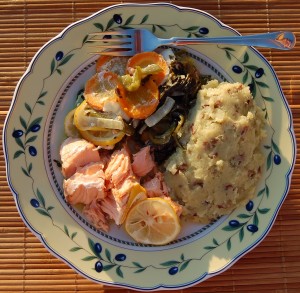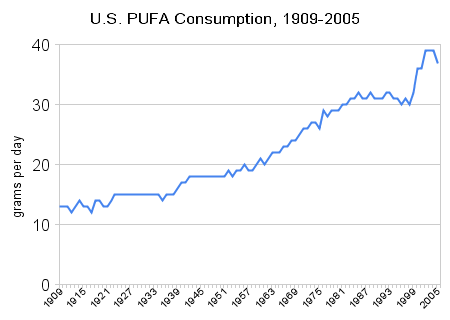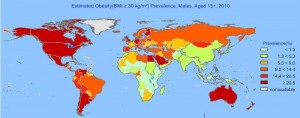We started 2011 with a discussion of Experiences, Good and Bad, On the Diet; which led us into the issue of weight loss, especially for peri-menopausal and older women.
This is an especially poignant issue for erp, who is 76 years old and would like to lose weight for her upcoming knee replacement surgery, but cannot walk.
This is the toughest possible scenario for weight loss:
- Whether for genetic (X vs Y chromosome) or hormonal reasons, women are more prone to putting on weight than men. (Men are more prone to diabetes.)
- Hormonal changes after menopause seem to make it tougher for women to lose weight.
- A petite woman doesn’t need as many calories as a larger person … but her micronutrient needs, and thus her appetite, may still be high.
- Aging brings more efficient energy utilization and reduced energy expenditure. Thus, the elderly have a smaller energy “sink” in which to dispose of excess fat. A teenager can eat like a horse and stay thin; not so an older person.
- An injury that prevents walking makes it even harder to burn off fat. Walking is a tremendous aid to fat loss.
Designing a weight loss diet for someone like erp really forces a hard look at how to optimize a weight loss diet. Get it even a little bit wrong, and the diet either won’t work for weight loss, or will be malnourishing.
The Three Keys for Weight Loss
The three keys for an effective and healthy weight loss diet, as I see it, are:
- Elimination of food toxins. Food toxins are the primary cause of obesity and you can’t expect to cure a condition by causing it!
- Perfect nourishment. The diet should be as nourishing as possible. The dieter should be in the “plateau range” of every nutrient – vitamins, minerals, organic molecules, carbs, protein, and fats.
- Calorie restriction. You have to be in energy deficit to lose weight.
The main food toxins to avoid are fructose, polyunsaturated fat, and wheat (see Why We Get Fat: Food Toxins). In my advice to erp, I suggested replacing some of her fruit with “safe starches” like potatoes, and replacing her PUFA-containing nuts with low-PUFA macadamia nuts or other foods.
But the harder part is achieving a calorie restricted diet when so few calories are being expended, and yet avoiding malnutrition. How may that be done?
Eat Protein and Carbs; Reduce Fat
This may surprise many readers, since we’re fat-friendly, but there should be no reduction in carb or protein consumption on weight loss diets. Calorie restriction should come out of fat.
The Perfect Health Diet “plateau range” for carbs and protein is 600 to 1200 calories. Eating less than 600 combined carb+protein calories per day raises the specter of either protein deficiency (leading to hunger) or glucose deficiency (leading to zero-carb dangers).
So if a typical daily intake is 400 carb calories and 300 protein calories, there’s really not much room to cut protein or carbs.
Remember that the body doesn’t have a significant store of carbs; the body’s total glycogen supply amounts to about a day’s needs. Nor does it have a store of protein, apart from skeletal muscle; and you don’t want to lose your muscle.
But it does have a large store of fat – those adipose cells that you want to shrink.
So to conserve muscle and reduce fat tissue, you have to eat your normal allotment of protein and carbs while restricting fat intake. As long as there is no serious dysfunction of adipose cells, they will release fat as needed to meet the body’s fat needs. And that’s what you want – fat being moved out of adipose cells to be burned.
So your calorie-restricted weight loss diet will be just as nourishing as your regular diet. Only the source of the nourishing fats – adipose cells instead of food – will be different.
Eat Nourishing Fats
But not all fat can be removed from the diet. The reason is that not all nutrients found in fat-containing foods are stored in adipose cells.
You see, fats are stored in adipose cells as triglycerides. But we need to get other lipid molecules, not just fatty acids, from food. The really crucial molecules are the phospholipids, especially phosphatidylcholine.
Choline, inositol, and a few others are organic molecules are bonded to fats in cellular membranes. We need to obtain these from our foods in order to be well nourished.
Diets low in choline strongly promote obesity. Therefore, anyone seeking to lose weight should be sure to eat a choline-rich diet.
The easiest way to do that is to eat 3 eggs a day and a ¼ pound beef liver once a week.
Another type of lipid that may be missing from adipose cells are omega-3 fats. Balancing the omega-6 to omega-3 ratio is helpful against obesity, and most people are omega-3 deficient. So eating up to 1 pound of salmon or sardines per week may assist weight loss.
Beef and lamb – meats that are low in omega-6 fats – would be good choices for any additional meat.
Be Super-Nourished
The body’s appetite regulation mechanisms are highly attuned to your micronutrient needs. Micronutrient deficiencies will tend to induce a strong appetite for food, as your body tries to get you to obtain more nutrition. This could be a major reason why “empty calories” such as cotton candy are fattening.
Our book has some examples of “micronutritious foods”: variety meats, bone soups, seaweed, shellfish, eggs, and vegetables.
Nutritious, low-calorie foods like bone soups can be very helpful for weight loss. Soups can also be a good way for someone who doesn’t like vegetables to obtain them.
In addition, I would recommend that every person on a weight-loss diet take our full supplement regimen: a daily multivitamin, D, K2, C, magnesium, copper, chromium, iodine, and selenium. Also, I would suggest taking our optional B vitamins: thiamin, riboflavin, pantothenic acid, biotin, vitamin B6, vitamin B12, and choline (note the exclusion of niacin and folic acid).
Keeping Calories Down
What is the minimum calorie intake that meets all these nutrient considerations? Eggs, salmon, and beef have more fat than protein, so if you’re aiming for 400 carb calories and 300 protein calories, you’ll probably eat at least 500 fat calories per day. So it would seem to be impossible to go below about 1200 calories per day while still being well nourished.
The place to cut calories, then, is the extra fats. Perfect Health Diet favorites like butter, coconut oil, and cream are, sadly, top candidates for reduction.
Of course, the more active you are, the more you can include those fats.
For less active people, the Weight Loss Version of the Perfect Health Diet becomes similar to a lot of popular diets. Many diets recommend a roughly even calorie distribution, with 30-40% of carbs, protein, and fats. This is what a calorie-restricted version of the Perfect Health Diet should look like too.
So, the perfect day in a weight loss diet: soup, potatoes or other safe starch, salmon, eggs, vegetables. Not too much fat in the sauces!
A good meal might look like this:

Mash the sweet potato with eggs instead of butter, and this would fit our weight loss recipe.
Conclusion
It’s a little humbling that I’ve started 2011 with 5 posts on the subject of healthy weight loss, but have only scratched the surface of this complex topic.
For instance: In the book we used the rubric “metabolic damage” to describe the biological dysfunction associated with obesity. But we never really chased the complex biology of exactly that damage consists of – and how it can best be healed.
Today, I’ve presented what I believe is the best strategy for healthy weight loss. But other techniques – such as ketogenic dieting, intermittent fasting, exercise, and more – can contribute to healing the metabolic damage of obesity. As 2011 goes on, I’ll return to this topic.
I am intensely interested in the experiences of anyone trying to lose weight using our diet, and I hope that together, we can understand the disease of obesity better, and figure out good ways to achieve both healthy weight loss and a permanent recovery from metabolic damage of all kinds. So please, if you are trying to lose weight, keep me posted on your experiences, whatever they may be!
Related Posts
From 2011:
- Water Weight: Does It Change When Changing Diets? Does It Matter?
- How Does a Cell Avoid Obesity?
- Why We Get Fat: Food Toxins
- Protein, Satiety, and Body Composition
- Low-Protein Leanness, Melanesians, and Hara Hachi Bu
From 2010:


















Recent Comments